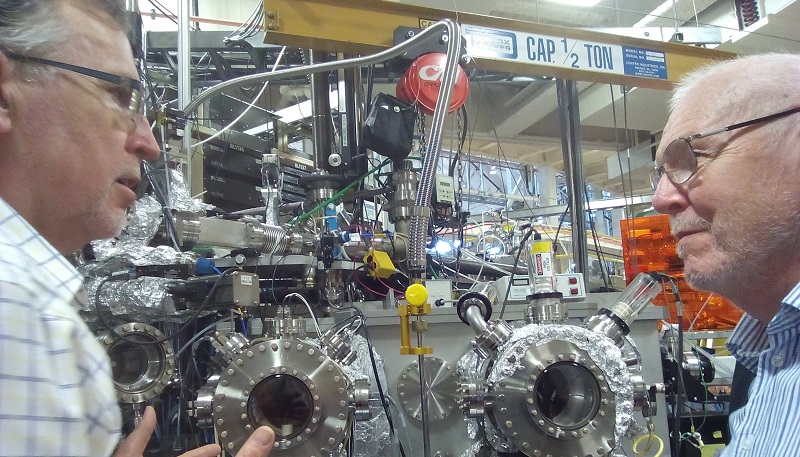Scientific solution to smashed smartphone screens?

Professor Neville Greaves (right) discusses the results on molten glass in the Advanced Light Source laboratory at the University of Berkeley, California.
08 December 2017
Smashed smartphone screens could be a thing of the past, thanks to a new discovery by university researchers.
A team of scientists from Aberystwyth University, the Australian National University, the Institut de Physique du Globe in Paris, and Orléans University in France have been studying the structure of different types of novel glasses at the atomic level and the way they flow when molten at over 2000 degrees.
They have just reported their results in Scientific Reports published by Nature.
They have been looking in particular at the structure of alumino-silicate glasses which are used in a range of industrial processes, including the manufacture of screens for hand-held devices.
Professor Neville Greaves from the Department of Physics at Aberystwyth University is part of the team looking at improving the resistance of such glasses to fracture and corrosion.
“Everyone knows how frustrating it is when you drop your mobile device, and get a large fracture in the nice screen, also when it marks if it gets wet,” said Professor Greaves.
“With our new knowledge, industry should be able alter the glass structure to promote the tiny channels present we have discovered to inhibit propagation of nanometric cracks, to improve the resistance of your cellphone screen to fracture and corrosion. This idea is kind of similar to that of drilling a hole at the tip of a crack in a metal sheet to stop the crack in its tracks.”
As part of the research project, glasses were melted at temperatures of over 2,000 degrees and their structure simulated by massive computational calculations, enabling scientists to identify their molecular structure, the exact location of different atoms, and the way molten glass flows.
Other potential applications for their research include the production of highly-resistant glasses which imprison radionuclides and which can therefore be used to safely store nuclear waste for long periods of time.
The research on molten glasses could also lead to better modelling of present volcanic activity such as Bali’s Mount Agung, as well as the original formation of Earth and its surface.
The full team working on the project include Professor Neville Greaves, Wenlin Chen and Zhongfu Zhou from Aberystwyth University; Charles LeLosq from the Australian National University; Daniel Neuville from the Institut de Physique du Globe, Paris, France; and Pierre Florian and Dominique Massiot from the Extreme Conditions and Materials Centre at Orléans University in France.
They have published their latest findings in Scientific Reports - the online, open access journal from the publishers of Nature https://www.nature.com/articles/s41598-017-16741-3.
The team members are also collaborating with industry, including Corning in the United States and the State Key Laboratory of Silicate Materials for Architectures at Wuhan University of Technology.



